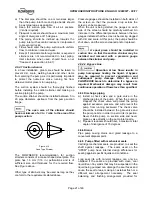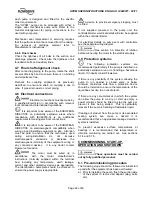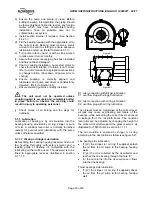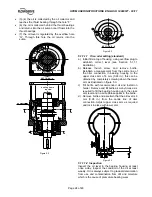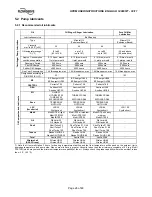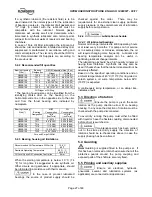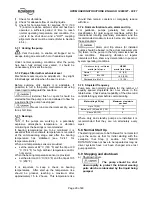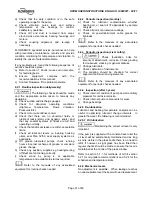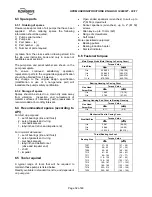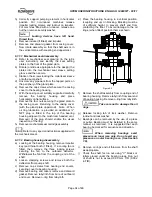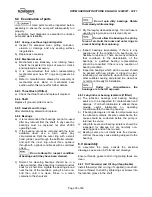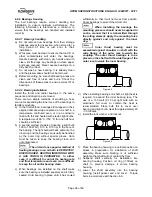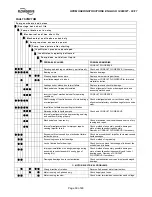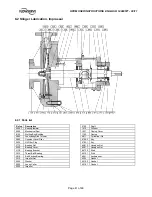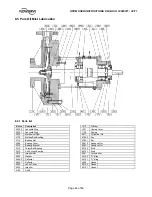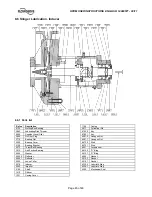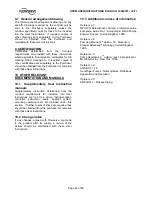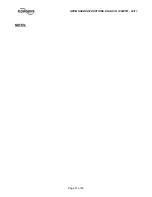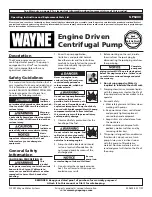
HPXM USER INSTRUCTIONS ENGLISH 14983571 - 03/11
Page 35 of 48
6.8 Examination of parts
Used parts must be inspected before
assembly to ensure the pump will subsequently run
properly.
In particular, fault diagnosis is essential to enhance
pump and plant reliability.
6.8.1 Casing, seal housing and impeller
a) Inspect for excessive wear, pitting, corrosion,
erosion or damage and any sealing surface
irregularities.
b) Replace as necessary.
6.8.2 Mechanical seal
a) Mechanical seal stationary and rotating faces
should be inspected for signs of wear or cracks
and replaced as necessary.
b) It is recommended that when reassembling
mechanical seal new "O" rings and gaskets be
used.
c) Refer to manufacturers drawing for assembly of
mechanical seal. Refer to mechanical seal
section within this manual for further details.
6.8.3 Throat Bush (If fitted)
a) Check the throat bush and replace if required.
6.8.4 Shaft
Replace if grooved, pitted or worn.
6.8.5 Gaskets and O-rings
After dismantling, discard and replace.
6.8.6 Bearings
a) It is recommended that bearings are not re-used
after any removal from the shaft. In any case the
bearings must be replaced not after 25000
operating hours.
b) If the bearing cannot be removed with the tools
available never use a torch under any
circumstances. Split the outer ring with a small
hand grinder, saw through the ball/roller retainer,
and split the inner ring about three quarters
through with a grinder and break with a cold steel
chisel.
Do not attempt to inspect condition
of bearings until they have been cleaned.
c) Solvent for cleaning bearings should be in a
clean container. Place bearings in solvent and let
soak for a short time. Agitate the bearing around
near the top of the container, giving it a turn now
and then until it is clean. Rinse in a clean
container of fresh solvent.
Do not spin dirty bearings. Rotate
them slowly while washing.
d) Dry thoroughly cleaned bearings. If an air hose is
used for drying, make sure it is clean dry air.
Do not allow the bearings to spin by
force of air. Hold the inner and outer rings to
prevent bearing from spinning.
e) Inspect bearings immediately. If there is any
question as to the condition of a bearing do not
hesitate to replace it. There are many conditions
that contribute to the deterioration of the
bearings. A qualified bearing representative
should be consulted if there is any question of
bearing condition.
f) Inspected bearings which will be reused should
be packed with new grease or dipped in clean
lubricating oil, covered with clean lint free rags or
other suitable covering and placed in a clean box
or carton until ready for installation.
Under no circumstances the
bearings are to be left exposed.
6.8.7 Labyrinths or bearing isolators (if fitted)
a) The lubricant, bearings and bearing housing
seals are to be inspected for contamination and
damage. If oil bath lubrication is utilised, these
provide useful information on operating
conditions within the bearing housing.
b) If bearing damage is not due to normal wear and
the lubricant contains adverse contaminants, the
cause should be corrected before the pump is
returned to service.
c) Labyrinth seals and bearing isolators should be
inspected for damage but are normally non-
wearing parts and can be re-used.
d) Bearing seals are not totally leak free devices.
Oil from these may cause staining adjacent to the
bearings.
6.9 Assembly
To assemble the pump consult the sectional
drawings, see section 8,
Parts list and drawings
.
Ensure threads, gasket and O-ring mating faces are
clean.
6.9.1 Oil Thrower(s) and Oil ring (if applicable)
Install thrower(s) and oil ring (if supplied) onto shaft.
Secure thrower to shaft by tightening set screws into
the location groove in the shaft.

